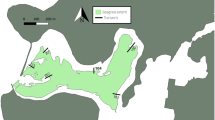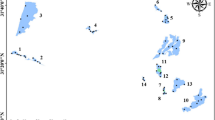Abstract
We used paleolimnological methods to investigate spatial and temporal patterns of bulk sediment and nutrient (C, N, P) accumulation in Lakes Hell ‘n’ Blazes (A = 154 ha, zmax = 240 cm), Sawgrass (A = 195 ha, zmax = 157 cm) and Washington (A = 1766 ha, zmax = 322 cm), in the Upper St. Johns River Basin, Florida. The study was designed to evaluate long-term changes in sedimentation and nutrient storage in the basin, and was one component of a larger project addressing flood control, wetland restoration, and water quality improvement. These three study lakes are wide, shallow waterbodies in the upper reaches of the St. Johns River channel. Sediment mapping indicates soft, organic deposits are distributed uniformly throughout Lakes Hell ‘n’ Blazes and Sawgrass. In contrast, much of Lake Washington is characterized by sandy bottom, and organic sediment is largely restricted to the north end of the lake. Lakes Hell ‘n’ Blazes and Sawgrass are effective sediment traps because dense submersed macrophytes and their associated epiphytes reduce flow velocity, intercept suspended particles, and utilize dissolved nutrients. Abundant Hydrilla, combined with short fetch, prevents resuspension and downstream transport of sediments. Larger Lake Washington is probably wind-mixed and resuspended organic sediments are redeposited to downstream sites. 210Pb-dated sediment cores show that organic sediment accumulation began in all three lakes before 1900, but that bulk sediment and nutrient accumulation rates have generally increased since then. The increases are probably attributable, in part, to anthropogenic activities including 1) hydrologic modifications that reduced flow rates in the channel, 2) discharge of nutrient-rich waters from urban, agricultural and ranching areas, and, 3) introduction and periodic herbicide treatment of the exotic macrophytes Eichhornia and Hydrilla.
Similar content being viewed by others
References
Aldridge, F.J., Chapman, A.D., Schelske, C.L. and Brody, R.W. 1998. Interaction of light, nutrients and phytoplankton in a blackwater river, St. Johns River, Florida, U.S.A. Verh. Internat. Verein. Limnol. 26: 1665-1669.
Appleby, P.G. and Oldfield, F. 1983. The assessment of 210Pb data from sites with varying sediment accumulation rates. Hydrobiologia 103: 29-35.
Appleby, P.G., Nolan, P.J., Gifford, D.W., Godfrey, M.J., Oldfield, F., Anderson, N.J. and Battarbee, R.W. 1986. 210Pb dating by low background gamma counting. Hydrobiologia 143: 21-27.
Belanger, T.V., Van Vonderen, S.D. and Carberry, T.J. 1983. Analysis of selected water quality factors in the St. Johns River Basin. Report to the St. Johns River Water Management District, Palatka, FL. 114 pp.
Binford, M.W. 1990. Calculation and uncertainty analysis of 210Pb dates for PIRLA project lake sediment cores. J. Paleolimnology 3: 253-267.
Binford, M.W. and Brenner, M. 1986. Dilution of 210Pb by organic sedimentation in lakes of different trophic states, and application to studies of sediment-water interactions. Limnol. Oceanogr. 31: 584-595.
Brenner, M., Peplow, A.J. and Schelske, C.L. 1994. Disequilibrium between 226Ra and supported 210Pb in a sediment core from a shallow Florida lake. Limnol. Oceanogr. 39: 1222-1227.
Brenner, M., Whitmore, T.J., Curtis, J.H. and Schelske, C.L. 1995. Historical ecology of a hypereutrophic Florida lake. Lake Reservoir Managmt. 11: 255-271.
Brenner, M., Whitmore, T.J. and Schelske, C.L. 1996. Paleolimnological evaluation of historical trophic state conditions in hypereutrophic Lake Thonotosassa, Florida, USA. Hydrobiologia 331: 143-152.
Brenner, M., Schelske, C.L. and Whitmore, T.J. 1997. Radium-226 stratigraphy in Florida lake sediments as an indicator of human disturbance. Verh. Internat. Verein. Limnol. 26: 809-813.
Campbell, D., Munch, D.A., Johnson, R., Parker, M.P., Rao, D.V., Marella, R. and Albanesi, E. 1984. St. Johns River Water Managemnt District. In:Fernald, E.A. and Patton, D.J. (eds), Water Resources Atlas of Florida. pp. 158-177. Florida State University Press, Tallahassee, FL.
Canfield, D.E. Jr., Shireman, J.V., Colle, D.E., Haller, W.T., Watkins, C.E. II and Maceina, M.J. 1984. Prediction of chlorophyll aconcentrations in Florida lakes: importance of aquatic macrophytes. Can. J. Fish. Aquat. Sci. 41: 497-501.
Carpenter, S.R. and Lodge, D.M. 1986. Effects of submersed macrophytes on ecosystem processes. Aquatic Bot. 26: 341-370.
Cox, D.T., Moody, H.L., Vosatka, E.D. and Hartzog, L. 1976. D-J F-25 Stream investigations completion report. Florida Game and Fresh Water Fish Commission, Tallahassee, FL. 848 pp.
Dieter, C.D. 1990. The importance of emergent vegetation in reducing sediment resuspension in wetlands. J. Freshwater Ecol. 5: 467-473.
Fisher, M.M., Brenner, M. and Reddy, K.R. 1992. A simple, inexpensive piston corer for collecting undisturbed sediment/water interface profiles. J. Paleolimnology 7: 157-161.
Florida Statistics 1995. University of Florida. Bureau of Economic and Business Research. (abstract).
Håkanson, L. and Jansson, M. 1983. Principles of lake sedimentology. Springer-Verlag, NY. 316 pp.
Hall, G.B. 1987. Establishment of minimum surface requirements for the greater Lake Washington basin. St. Johns River Water Management District Technical Publication SJ 87-3, Palatka, FL. 74 pp.
Knoll, G.E. 1989. Radiation detection and measurement. 2nd Edn. J. Wiley & Sons, New York. 762 pp.
Krishnaswami, S. and Lal, D. 1978. Radionuclide limnochronology. pp. 153-177. In:Lerman, A. (ed.), Lakes: Chemistry, Geology, Physics. Springer-Verlag, New York.
Lowe, E.F., Brooks, J.E., Fall, C.J., Gerry, L.R. and Hall, G.B. 1984. Technical Publication SJ 84-15. U.S. EPA Clean Lakes Program, Phase I. Diagnostic-feasibility study of the Upper St. Johns River chain of lakes. Volume I - diagnostic study. Department of Water Resources, St. Johns River Water Management District, Palatka, FL. 118 pp.
Oldfield, F. and Appleby, P.G. 1985. Empirical testing of 210Pb-dating models for lake sediments. In:Haworth, E.Y. and Lund, J.W.G. (eds), Lake Sediments and Environmental History. pp. 93-124. U. Minnesota Press, Minneapolis.
Schelske, C.L., Conley, D.J., Stoermer, E.F., Newberry, T.L. and Campbell, C.D. 1986. Biogenic silica and phosphorus accumulation in sediments as indices of eutrophication in the Laurentian Great Lakes. Hydrobiologia 143: 79-86.
Schelske, C.L., Peplow, A., Brenner, M. and Spencer, C.N. 1994. Low-background gamma counting: applications for 210Pb dating of sediments. J. Paleolimnology 10: 115-128.
Sincock, J.L. 1958. Waterfowl ecology in the St. Johns River Valley as related to proposed conservation areas and changes in the hydrology from Lake Harney to Ft. Pierec, Florida. Florida Game and Fresh Water Fish Commission Pittman-Robertson Project Report W-19-R, Tallahassee, FL. 89 pp.
St. Johns River Water Management District. 1980. Upper St. Johns River basin surface water management plan, volume 2. St. Johns River Water Management District, Palatka, FL. 500 pp.
Tai, C.C. and Rao, D.V. 1982. Hydrologic change due to floodplain impoundment and encroachment by agricultural activities. In:Kruse, E.G., Burdick, C.R. and Yousef, Y.A. (eds), Environmentally Sound Water and Soil Management. pp. 193-200. American Society of Civil Engineers, New York, NY.
Whitmore, T.J., Brenner, M. and Schelske, C.L. 1996. Highly variable sediment distribution: a case for sediment mapping surveys in paleolimnological studies. J. Paleolimnology 15: 207-221.
Author information
Authors and Affiliations
Rights and permissions
About this article
Cite this article
Brenner, M., Keenan, L., Miller, S. et al. Spatial and temporal patterns of sediment and nutrient accumulation in shallow lakes of the Upper St. Johns River Basin, Florida. Wetlands Ecology and Management 6, 221–240 (1998). https://doi.org/10.1023/A:1008408030256
Issue Date:
DOI: https://doi.org/10.1023/A:1008408030256




